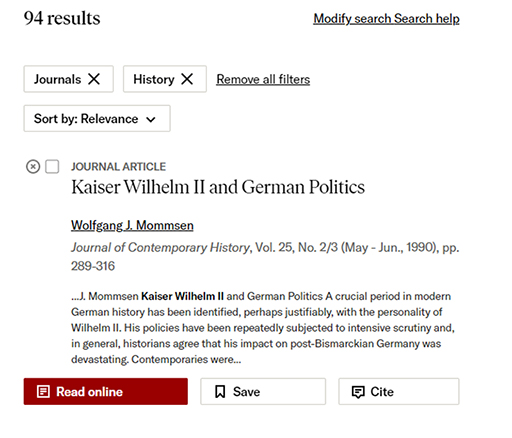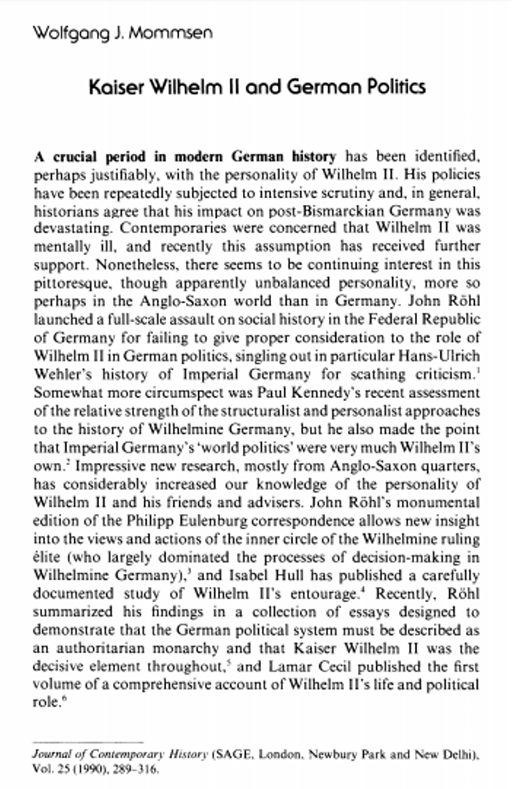7 Using PROMPT in practice
Although these types of books and articles serve slightly different purposes and may well be written in rather different registers, the way in which you would go about assessing them using PROMPT is fairly similar. Remember that we are looking here for the most efficient way of evaluating what might be a fairly long list of potential sources.
Assuming that you’ve searched Google Scholar, JSTOR or another suitable database and have used filters to reduce the number of options to a manageable size, the next step would be to skim over the titles in the list (including the titles of the journals or books) and also, if available, examine the ‘keywords’ or ‘topics’ to check that the article is potentially relevant (this is a helpful feature in JSTOR, but not all databases have it).
With luck, that check ought to help answer some of the provenance, relevance and timeliness sub-questions, which in turn should whittle the possibilities down to single figures. From those results, we’d recommend that you choose the three or four that seem most relevant and then interrogate them in the following order, looking again for the answers to the PROMPT questions.
For journal articles, ordinarily the most efficient order in which to assess the text itself is Abstract > Conclusion > Introduction > Body Text.
The abstract (or summary) is an important indicator of relevance, since it is therein that authors tend to summarise their arguments, explain briefly their methods, situate their work within historical debates and indicate the structure of the piece. Although they are sometimes rather densely written, and need to be read carefully, you can usually gather sufficient information from the abstract to decide whether or not it is worth continuing with the article.
If, however, it does not satisfy you in terms of the PROMPT criteria, then the subsequent stage would usually be to examine the article’s conclusion, since that is likely to be the next shortest segment of the article and the place where the author should make their interpretation explicit. It is unlikely that you would be unable to decide on an article’s utility by that point, but there may be occasions on which, for instance, the methodology adopted by the historian is unclear from those sections; in that event, the introduction would likely be useful.
More on PROMPT process
For your students, it would be helpful to call attention to the complexity of the language and concepts employed in any articles they find; those complications should also be revealed by the PROMPT process of reading and assessing. Scholarly articles are written principally for historians’ peers, so are sometimes pitched at an inappropriate level for GCSE and A Level students’ comprehension. That, too, is covered under the PROMPT criteria (under presentation) and should help rule out an article that is too complicated for students to understand.
That said, there is a downside to this method. Until perhaps 20 years ago, it was entirely normal in our discipline for articles to appear without an abstract. So, for older works, which are of course regularly used by the boards in their examination papers, it would be wise to start with the first couple of paragraphs of an article’s introduction, which often have similar features to an abstract, before moving to the conclusion and then back to the remainder of the text, looking especially at topic sentences in the first instance. This is not perfect, and is likely to be slightly more time-consuming, but should nevertheless yield enough information to make an evaluation using PROMPT.
For books, there’s a comparable procedure, though the first thing to establish is whether the volume is a monograph (i.e., single-authored) or a collection of essays (multi-authored). For multi-authored volumes on a single theme, it is normally best to treat each chapter like a journal article – though the caveat about absence of abstracts should be borne in mind. Single-authored books, on the other hand, are more likely to sit with the ‘seminal literature’ that advances wider interpretations, and you may well want your students to engage with those in addition to, or instead of, journal articles. (Incidentally, most exam boards consider the use of a single chapter from a book to be one acceptable source for an NEA project.) As with shorter forms of academic literature, though, the principle still holds of examining first those sections of the book that are most likely to offer answers to the PROMPT questions. That means an order of reading that probably follows this pattern: opening pages of the introduction > conclusion > initial pages of individual chapters – but this is not a hard-and-fast rule.
Activity 4 Assessing potential secondary sources
As this process can be baffling for students when they first encounter it, you might like to try this worked example with them in the classroom. It uses the subject of the causes of the First World War – which, as Session 1 of this course makes clear, remains a highly contested debate – to illustrate the steps that the students should go through.
First, go to JSTOR and search for ((“first world war”) AND (“ Kaiser Wilhelm II”) AND causes). If you limit your search to journal articles and select History in the subject section, you should have Wolfgang Mommsen’s ‘Kaiser Wilhelm II and German Politics’ (1990) in the Journal of Contemporary History as one of your top hits.
Reflect on which of the PROMPT questions can be answered simply from the information in the results list. What advice might you give students to interrogate the source further before they decide whether or not to read the article?
Comment
Some of the questions on provenance, relevance and timeliness can be answered from this information alone. So far, the article is passing the test. Before opening the PDF copy, though, it would be a good idea to suggest to your students to investigate the author. Mommsen was one of the many important contributors to the Fritz Fischer debate that you can read about in Session 1, but it’s unlikely that your students would know that.
Since some exam boards require A Level project work to assess the academic and political context in which historians write, as well as the approaches that they take, fostering the habit of ‘getting to know your historian’ is likely to be useful. If a historian is still active, they are likely to be attached to a university department, most of which (in the UK, at least) will have a public web page that lists staff and their research specialities.
Generally, it should be painless enough to find the scholar via a standard search engine. Your students could try this by looking up Heather Jones, the author of the historiographical review mentioned in Activity 2, as an example.
Wolfgang Mommsen, on the other hand, is no longer with us, but that does not mean the trail has gone cold. It is perfectly acceptable in such cases to use Wikipedia, or an equivalent tertiary source, to discover more. Students should be looking for indicators such as authors’ bibliographies, major works, institutional affiliations and positions in key debates. Mommsen’s Wikipedia entry provides information on all of these; consequently, it should both reassure students about the article’s provenance and give them material to help in their coursework.
Opening the PDF will confront the students with a common predicament: it has no abstract. Following the reading sequence outlined above ought to deliver enough clues to answer the remainder of the PROMPT questions on method, relevance, presentation and objectivity. The article’s opening paragraphs give a sense of the debates with which Mommsen intends to engage and hints at some of the sources he means to employ. Looking at the introductory and concluding paragraphs would be a good way to assess if the article is potentially useful.
Switching to the conclusion provides a clear sense of his argument. Obviously, Mommsen’s concerns in the article were far wider than simply addressing the question of the First World War’s origins. Having read the conclusion, and depending on their exact focus, a few students might decide that the piece is insufficiently relevant to use. There is no harm in that – it demonstrates the utility of the PROMPT technique because it has spared them the necessity of reading the whole article. Those who want to continue should then go to the body text and read topic sentences in the first instance to see how the article is structured and its principal topics.
At this stage, it can also be fruitful to glance at footnote references to check the types of evidence on which an author has drawn. In any article or book chapter, students are likely to encounter several terms, places and names with which they will be unfamiliar. It is best not to stop and look up such things while still making an assessment of a source’s value, since it will deflect from the purposes of the PROMPT exercise. Naturally, if a secondary source is thought worth using, then investigating those terms forms part of the process of learning and composition.
Skimming through the article, reading topic sentences chiefly, ought to reveal that only one quarter or so of the text deals directly with Germany’s role in the outbreak of the First World War. Students whose topic or assignment is concerned primarily with the war’s causes would probably have been correct to reject the article on the grounds of relevance at an earlier stage. In cases where their focus is less narrow, though – on pre-war diplomacy, say, or the internal politics of Imperial Germany – then the article should satisfy all the PROMPT criteria and students can happily use it in their work. Moreover, if the focus is historiographical, then Mommsen is making an important intervention, and his work could be usefully included in an assignment.
There are, of course, other ways in which students can contextualise and understand secondary material once it has been chosen. If the source is a book, for example, then searching for reviews on Google Scholar and/or JSTOR might well be helpful. Indeed, long book reviews and historiographical overviews, such as those found on the Institute of Historical Research’s Reviews in History site, could themselves be classed as legitimate sources for the type of sustained investigation envisaged by NEA projects.
Hopefully these tips will assist your students in selecting their secondary sources. In the next section, you will look in detail at strategies for helping them find and assess online primary sources.



